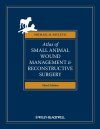![Atlas of Small Animal Wound Management and Reconstructive Surgery Atlas of Small Animal Wound Management and Reconstructive Surgery]()
Click to have a closer look
About this book
Contents
Biography
Related titles
About this book
This full-color atlas presents essential information on basic principles of wound healing and wound management, common wound complications and general surgical considerations. The new edition presents a wider variety of topics including skin fold disorders, urogenital surgery, new flap techniques, and an expanded chapter on facial reconstruction. It also contains 40 new plate illustrations, including new sections on bandage and splint techniques, and features significant updates on wound healing physiology, equipment and dressing materials.
Contents
1. The Skin. Skin Function. Skin Structure. Cutaneous Adnexa. The Hypodermis. Cutaneous Circulation. Congenital Skin Disorders. 2. Basic Principles of Wound Healing. Wound Healing. Species Variations in Wound Healing. Artificial Skin. 3. Basic Principles of Wound Management. Patient Presentation. Mechanisms of Injury and Wound Terminology. Wound classification. Options for Wound Closure. Healing by Adnexal Re-epithelialization. Pointers in Selecting the Proper Closure Technique. Basic Wound Management in Six Basic Steps. 4.Wound Care Products and The Use. Wound Drainage Systems. Topical Wound Care Products. Alternative Forms of Wound Therapy. Concluding Remarks. 5. Dressings, Bandages, External Support, and Protective Devices. Introduction. Composition of a Bandage. Preventing Bandage Displacement. Tie-over Dressing/Bandage Technique. Pressure Points: Bandage Options. Bandage "Access Windows". Bandaging Techniques for Skin Grafts. Bandaging Techniques for Skin Flaps. Splints, Casts, Reinforced Bandages Miscellaneous Protective Devices. 6. Common Complications in Wound Healing. Improper Nutritional Support. Hypovolemia and Anemia. The Nonhealing Wound: General Considerations. Failure to Heal by Second Intention. Scarring and Wound Contracture. Infection. Draining Tracts. Use of Tourniquets for Lower Extremity Procedures. Seromas. Hematomas. Exposed Bone. Wound Dehiscence. 7. Management of Specific Wounds. Bite Wounds. Burns. Inhalation Injuries. Chemical Burns. Electrical Injuries. Radiation Injuries. Frostbite. Projectile Injuries. Pressure Sores. Hygroma. Snakebite. Brown Recluse Spider Bites. Porcupine Quills. 8. Regional Considerations. The Canine Profile. The Feline Profile. 9. Tension Relieving Techniques. Introduction. Skin Tension in the Dog and Cat. 10. Skin-Stretching Techniques. Physiology of Skin Stretching. Presuturing. Skin Stretchers. Skin Expanders. 11. Local Flaps. Introduction. Advancement Flaps. Rotating (Pivoting) Flaps. 12. Distant Flap Techniques. Distant Flaps. Direct Flap. Indirect Flap. The Delay Phenomenon. 13. Axial Pattern Skin Flaps. Introduction: Axial Pattern Flaps. Island Arterial Flaps. Reverse Saphenous Conduit Flap. Secondary Axial Pattern Flaps. 14. Free Grafts. Free Skin Grafts. Classification of Free Grafts. Graft Thickness. Partial Coverage Grafts. Dermatomes. Preservation by Refrigeration. Intraoperative Considerations. Bandaging Technique for Skin Grafts. 15. Facial Reconstruction. Introduction: Facial Reconstructive Surgery. on With Inverse Tubed Skin 16. Myocutaneous Flaps and Muscle Flaps. Introduction. Myocutaneous Flaps. Muscle Flaps. 17. Oral Reconstructive Surgical Techniques. Introduction. 18. Foot Pad Reconstruction. Introduction. Pad Laceration and Lesion Excision. Digital Pad Transfer. Metacarpal/Metatarsal Pad Transfer. Accessory Carpal Pad. Pad Grafting. Digital Flaps for Wound Closure. Fusion Podoplasty. 19. Major Eyelid Reconstruction. Introduction. The Eyelids. 20. Nasal Reconstruction Techniques. Introduction. Traumatic Wound Management. Neoplasia. Neoplasms and Surgical Margins. Nasal Reconstruction Options. 21. Cosmetic Closure Techniques. Cosmetic Considerations. Causes of Scars. Minimization of Scarring. 22. Preputial Reconstructive Surgery. Introduction. Surgical Conditions. Surgical Techniques. 23. Miscellaneous Reconstructive Surgical Techniques. Omentum. Scrotum. Tail Fold Intertrigo. Vulvar Fold Pyoderma. Surgery of the Pinna. Index.
Customer Reviews
Biography
Michael M. Pavletic, DVM, Diplomate ACVS, is director of surgical services at Angell Animal Medical Center in Boston, Massachussetts.



































